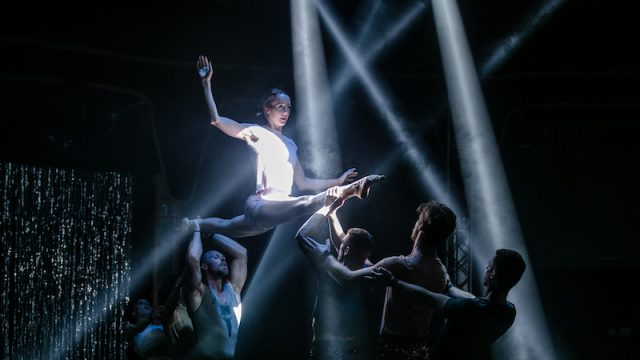Review from: Underbelly Festival Southbank, London; 18th July, 2018

When thinking about the biggest and most influential contemporary circus companies, Circa is one of the names which immediately comes to mind*. The Australian company has multiple productions running in cities around the globe and has developed a strong brand of aesthetics, a visual language rooted in ensemble acrobatics, and choreography that celebrates the individual physicalities of its artists.
Much of Circa’s work is without story-based narrative and is instead composed of scenes and vignettes which ebb, flow and weave in and out of one another. Peepshow is no different. In the opening scene, hula hoops are thrown and caught along with the cast members themselves, and formations of bodies build, disintegrate and re-form to fill the entire stage space with limbs. There is solo rope from Ela Bartilomo, beautiful contortion hand balance from Nathan Knowles that evokes the thin line between pleasure and pain, and an innovative, stylised silks acts from Billie Wilson-Coffey where (with the help of the rest of the cast) the black fabric is morphed into a sentient, seething, other worldly being.

The main body of the show is the ensemble acrobatics that typify Circa productions. Flyers are spun and tossed up to be caught in the arms of someone already on another persons shoulders, unfathomable basing positions that it seems impossible to bear weight in, and choreography that subtly subverts the ‘classic lines’ of circus – one of the various three-highs formed in the show is so perilously twisted that it is less reminiscent of a sturdy tower and more of a tortured spiral staircase. There were a few drops and shuffles on the night I attended, but the cast brushed these aside in the way that reassured the audience of their professionalism and reinforced the precarious and vital live-ness of circus work.

While the core structure and physical language of Peepshow is very typical for the company, the tone and style make it feel as though you are watching a Circa performance through a slightly warped Lynchian mirror. Everything feels a little heightened, the gestures of the artists are slightly weirder, the circa-staple hot pants have more sequins, and the soundtrack is a playlist of weimar-esque renditions and uncanny covers of cult classics (including the Eurythmics and the Velvet Underground) giving it a slightly more subversive edge. The very considered and highly stylised lighting design (Jason Organ & Richard Clarke) is a mix of miss-directed spotlights and disorientating strobes that pick up the haze and smoke and force the audience to look around, through and past as much as at the artists. I, for one, really enjoy this vamped-up aesthetic.

There are also moments of lightheartedness, and scenes more akin to the expectations set by the title ‘Peepshow’. Hot pink evening gloves, cheeky stripteases, and acrobatic parodies of showgirl posturing create scenes which are unashamedly ‘Burlesque’ in every sense of the word, and provide contrast in the show – light and shade, laughs to compliment the awe, and possibly also something more reassuringly familiar for a commercial audience to hold onto amongst the surrealism and extraordinary physicality.

It is difficult to write about Circa without making mention of the way in which the company allows its female cast members to be seen on stage. As an industry where the roles and narratives offered up for female artists is coming under increased scrutiny, Circa is a strong example of a company which allows women to be strong, to base, to middle, to work, to be seen to sweat and to support as much as they are supported. Peepshow follows this trahectory, and there is no shortage of female basing, middling and catching in the show. Circa women do not exist to be a weightbag with a face, or to smile blithely at the top of the three-high. They, like their male counterparts, are powerful, strong, have agency and personality, and it is wonderful to watch these qualities shine through.

In conclusion, Peepshow is more adult, a shade darker than other productions that I’ve seen before but without losing the overall Circa feel. Atmospheric and exciting, with all the technical prowess expected, this feels like a strong addition to the Circa canon.



